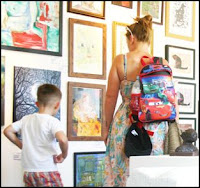In March 2016, I very excitedly booked our second annual auction at 'The Meeting Place' in The Orchards Shopping Centre, Dartford. After our successful first auction here we were looking forward to creating a repeat performance, carefully timing it to finish just before the turning on of the Christmas lights.
However, as we moved closer to the event and began to send out word and advertising to our contacts about the coming auction, we thought we should just confirm with the shopping centre that everything was okay to go ahead.
It wasn't.
During the year, the management at Dartford Shopping Centre had had a restructuring, and during this time the record of our booking for the auction had been lost. It was a big shock to everyone, as we had already done a large part of the work towards our yearly auction.
However, with the quick thinking of The Orchards Shopping Centre management and a lot of rescheduling for some very understanding groups who use 'The Meeting Place', with days to spare, the auction was back on!
 |
| Even the volunteer's children lent a helping hand with moving the furniture, taking pictures and keeping each other occupied with some quiet games and laughter. |
 |
| A huge display of paintings were hung, covering the walls. |
 |
| A visitor admiring a painting 'Full Sail' by Trevor Whitting. |
 |
| Sculptures are a relatively new addition to the auction as we expand on sculpture workshops at Centrepieces throughout the year. |
 |
| There are always last minute preparations in organising the most efficient way to keep the best records, and to keep the auction running as smoothly as possible. |
 |
| A visitor admiring 'The Gypsies Promise' by Christianna Cassisa. |
Diana Donkor, our arts administrator and Geoff Norris our coordinator then worked frantically on a tight timescale to gather and catalogue all the artwork that was needed.
Hundreds of selected artworks were loaded into the cars and van of our hard working team, all artists and volunteers of Centrepieces; the work was then loaded into shopping trolleys so that we could maneuver them through the corridors of the shopping centre from the loading bay to the venue. Paintings were hung wherever we could find space, sculptures were displayed on the furniture we could find, and display tables were set up for cards, hand made jewellery and artwork to be sold there and then.
Once the artwork was all in place, the shoppers started to wander in to see what we had on offer. Artists and Centrepieces members were there for 3 days during opening hours waiting to talk to interested visitors who primarily came to see the wonderful artwork on offer, but were also very interested to hear of the personal stories of the artists, and how art for them can be therapy, an outlet and eventually a career!
Other stalls that were on display held Centrepieces greetings cards, small sculptures, unframed paintings, and handmade jewelry that were on sale throughout the viewing period, before the auction.
 |
| The large range of Karen Larkin's handmade jewellery on offer throughout the four day event. |
 |
| Members of the public admiring Karen Larkin's huge range of handmade jewellery. |
 |
| Stalls were also there for cards, sculptures, paintings and hand made jewellery available to be bought on the spot. |
 |
| Hand made pieces, jewellery, Christmas ornaments, keepsake boxes, and sculptures ~ a few of the extras on offer. |
Paul Adams our auctioneer adds a little interest or personal touch to every piece by remembering the stories he hears in conversation with our artists, members and other volunteers. He creates a great atmosphere with an easy and laid back humour, while keeping everything together with his professionalism.
After our auctioneer had familiarised himself with many of the artworks and gained some interesting background information about some of the pieces, we counted down the minutes until we could introduce ourselves to the audience that had slowly been filling the room, and start the auction.
 |
| Our auctioneer Paul Adams assisted by our lovely ceramics workshop tutor Denise Tarrant. |
The auction fell into a nice rhythm and many pieces were sold, some had advanced bids already for those bidders that couldn't attend the event and when the auction came to a close, Centrepieces had sold about a third of the artworks, and made over a thousand pounds, which was split with the artists 50/50.
 |
| Seconds before our auction was about to start. |
 |
| Our happy young assistants helped from beginning to end, and entertained and uplifted us with their endless energy and smiles! |
 |
| Thanks to some lovely helpers, we had a fantastic buffet to offer our volunteers and guests to the auction! |
Written by Christianna Cassisa
Photography and editing by George Banfield
- 11:59
- 0 Comments






























